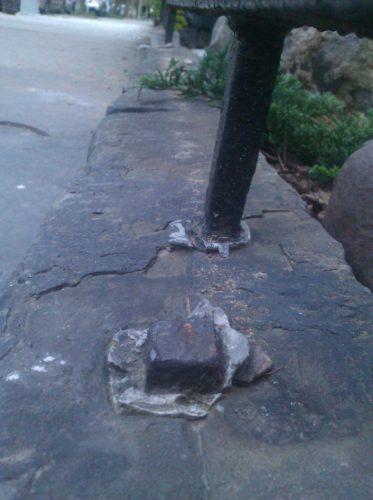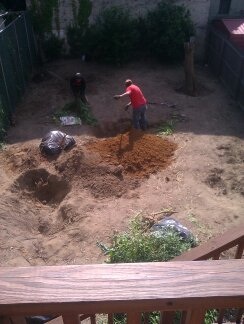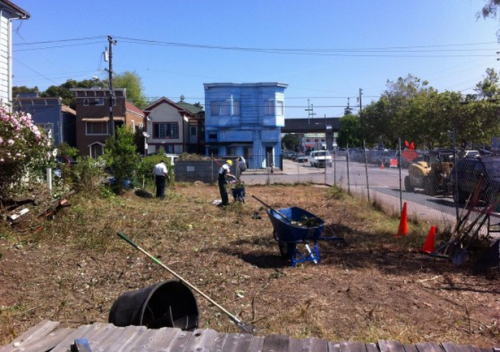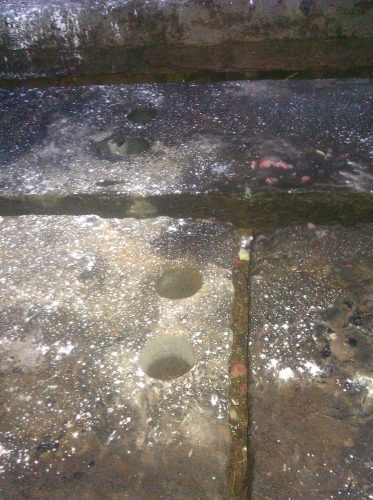Brooklyn prides itself in its historic buildings, but these same sites pose an often unknown toxicity risk to inhabitants. Although the use of lead products was outlawed decades ago – lead-based paints were taken off the market in 1978 and leaded gasoline was banned in 1989 – lead’s legacy continues to taint Brooklyn’ s soils. Lead does not break down or biodegrade but instead it sits there as a bioavailable chemical in the soil, meaning it can be assimilated by plants and animals. As water moves through soil, the lead leaches through soil profiles or lead laden dust is blown, resulting in the lead spreading to nearby lots.
The EPA advises remediation at lead levels of 400 ppm or higher, yet this is substantially higher than advised in many countries, where 100ppm is the average.
In terms of being exposed to lead, no minimum limit has been found at which lead ceases to be toxic. Small children may suffer brain damage, lowered I.Q., slow growth, and behavior problems, while adults may experience muscle pain, nerve disorders, reproductive problems, cognitive decline, and hypertension.
As a green builder in a lead-contaminated area, one of our primary concerns on a job site is lead containment. In our renovations we find lead everywhere – paint, posts, soil, pipes, railing ends, to name a few.

Our focus is to achieve our renovation goals while not exposing workers and clients to lead.
When New York customers come to us with soil remediation projects for their gardens we see lead concentration numbers around 800-4000 ppm. According the Dr Chang at Brooklyn College, where we get our soil tested, this is a very common range in New York.

Traditionally, the primary objective of lead remediation is to remove the lead from the site and move it to an area where people will not come in contact with it. This is the method recommended by Brooklyn College since it removes the lead from the site and is relatively foolproof if correct measures are taken to isolate the house if we are moving soil from the back yard of the brownstone to the front.
Our current service is limited to this method. Although very effective at soil remediation, it is labor intensive and consumes energy due to the need for trucking the soil back and forth.
Because of the drawbacks of typical soil remediation we are researching alternative means of lead remediation in order to improve our services and find more ecological and cost- and labor-efficient solutions.
Another option is phytoremediation, where plants are grown in the lead-contaminated soil, allowed to absorb the lead in their tissue, and then removed from the site. Accumulator plants such as sunflowers and the Brassica family are especially efficient at pulling lead out of the soil. It is very important that these plants are not eaten or used as compost, as this would return lead to the system or contaminate the consumer.
Phytoremediation is good in that it removes the lead from the site, although it does take many seasons for any significant lead reduction to occur. In New York, where every minute is crucial, and where most homeowners are seeking lead remediation because they have young children, waiting several years before playing in their back yard is not a practical option.
In the past 15 years scientists have begun to explore the concept of in situ stabilization, or binding the bio-available lead to other compounds in order to limit the concentration of lead in the soil that is actually digestible and therefore toxic to humans. The idea is to treat lead in place instead of simply moving the problem somewhere else. With these methods, lead will still show up on a simple soil test, but it is no longer free to contaminate plant tissue or humans. In essence it is no longer bioavailable or mobile.
Although some scientists are not keen on this approach since it does not remove the problem but merely renders it dormant, it does have some compelling ecological and cost benefits.
In situ stabilization has a couple elements. One is pH control, the other is binding the lead.
Lead is less bioavailable to plants and people in soils with a neutral pH. Soil pH can be controlled by bioremediation. Compost, or organic matter, balances pH levels in the soil while providing essential nutrients for your plants.
The synergistic benefit of adding organic matter like compost to lead tainted soil is that the lead also binds with the organic matter, limiting the amount of total bioavailable lead.
The most efficient form of in situ stabilization involves the use of chemical additions to the soil. Phosphates are a great option since as well as immobilizing lead they also bind with other heavy metals such as copper, zinc, cadmium, and uranium as well.

The EPA description for chemical in situ stabilization reads as follows:
Phosphate Immobilization – Using phosphate to bind with the lead, which will allow the metal to pass through the body if it is inadvertently ingested with significantly less harm; combined with
Green Capping – Using compost and green cover such as sod or planter boxes to create a protective layer above the treated soil
The most ideal phosphate source is fish bones. Judith Wright invented the process used to create apatite II, a phosphate mineral apatite particularly efficient at immobilizing lead (patent #6217775). It binds with lead to crystallize as pyromorphite.
She uses crushed Alaskan Pollock fish bones sourced from fisheries and found that when added to contaminated soil caused a 50% reduction in bioavailable lead within the span of a few weeks. Fish bones are free of contaminants and the use of a fishing industry by-product limits the overall contribution to environmental cost. Catfish bones have also been found to be appropriate for the process.
The product was applied in a large-scale project in the heavily contaminated South Prescott community of Oakland, California. Residents were asked to volunteer for remediation, which was handled by the EPA (the area is a superfund site). They were provided with one to two weeks of hotel accommodation for the duration of the work on their yards, as well as landscaping and design assistance post-remediation.
About 3 lbs of fish bones were tilled into each sq ft of contaminated yard, and then covered with 3-6 in of clean soil and plants. Landscapers would then arrive prepared with a series of conceptual yard designs from which to work from in order to restore the inhabitant’s gardens to the most ideal condition. The eco-friendly conceptual designs emphasized native plants, water efficiency, and maximized outdoor use.

The community embraced this method, as it was more cost efficient and environmentally friendly than typical remove and replace soil remediation techniques, while also reducing the disturbance caused by the remediation efforts (removing and carting tones of contaminated soil is not easy).
The traditional dig-and-haul method is estimated to cost $32 per sq ft while remediation via phosphate addition is generally around $18 a sq ft. However, these numbers are EPA estimates, which tend to be less cost-effective.
EcoBrooklyn charges a lot less than EPA estimates for dig-and-haul remediation but it still isn‘t cheap for something that looks the same once the job is done (dirt with lead or without still looks like dirt). The greatest contributor to our cost is labor and the demands of safely bringing toxic soil through a brownstone.
The importance of doing this correctly cannot be understated and we make no apologies for charging more than contractors who see the job as simply removing dirt from a yard. If done incorrectly more harm than good is done because now you have the lead contaminated back yard dust all over the INSIDE of the house. It is no joke.
EcoBrooklyn is very interested in in situ remediation for this reason. Not having to worry about safely moving toxic soil through a home would reduce our costs, so phosphate addition is something we are looking into seriously.
The active ingredient in fish bones is calcium phosphate. While apatite II is the optimal form of the compound for metal remediation, other forms of calcium phosphate have been tested and found to have significant effect on lead bioavailability. Tricalcium phosphate [Ca3(PO4)2]., dibasic calcium phosphate / dicalcium phosphate [CaHPO4], and hydroxy calcium phosphate [Ca10(PO4)6(OH)2] can also react with lead to form pyromorphite [Pb5(PO4)3Cl] and other insoluble lead compounds.
As mentioned before, a simple lead test will not show improvement post phosphate addition since the lead elements are still present. To evaluate the concentration of bioavailable lead, the EPA recommends obtaining an RBA value (relative bioavailability) via an IVBA assay (in vitro lead bioaccessibility). However, it has not yet officially approved the method for the assessment of phosphate amended soils.
A TCLP (toxic characteristic leaching procedure) test determines the mobility of both organic and inorganic analytes. This test would determine how much of the lead in the soil is mobile post phosphate-amendments, although its cost is prohibitive for a New York brownstone back yard soil remediation budget.
A study completed by the U.S. Military on a small arms firing range found that a 5% addition of hydroxyapatite or tricalcium phosphate lowered lead concentrations by 90-95%.
Dibasic calcium phosphate/dicalcium phosphate is a calcium nutritional supplement that can be obtained from some pharmacies and vitamin shops. EcoBrooklyn obtained pure dibasic calcium phosphate powder from Freeda Vitamins. We have been applying it on the recently salvaged lead-contaminated bluestone and soil in the Green Showroom yard. Since the powder is designed to be ingested as a nutritional supplement, the particles are not toxic to residents.

EcoBrooklyn is also in the process of obtaining apatite II. Although we will probably not stop removing the lead from the site since this undeniably removes the problem from the site, we do see the possibility of removing less soil and adding in situ remediation as part of the process. With these new tools such as phosphate amendments we hope to offer a wider range of lead contaminated soil remediation services to the New York area.


